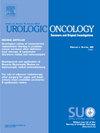Bempegaldesleukin plus nivolumab in first-line advanced/metastatic urothelial carcinoma: Results from a phase II single-arm study (PIVOT-10)
IF 2.4
3区 医学
Q3 ONCOLOGY
Urologic Oncology-seminars and Original Investigations
Pub Date : 2025-05-01
DOI:10.1016/j.urolonc.2024.09.030
引用次数: 0
Abstract
Background
In PIVOT-02, bempegaldesleukin (BEMPEG), a pegylated interleukin-2 cytokine prodrug, in combination with nivolumab (NIVO), a Programmed cell death protein 1 inhibitor, demonstrated the potential to provide additional benefits over immune checkpoint inhibitor monotherapy in patients with urothelial carcinoma, warranting further investigation. We evaluated BEMPEG plus NIVO in cisplatin-ineligible patients with previously untreated locally advanced or metastatic urothelial carcinoma.
Methods
This open-label, multicenter, single-arm, phase II study enrolled patients with locally advanced/surgically unresectable or metastatic urothelial carcinoma and who were ineligible for cisplatin-based treatment. Patients received BEMPEG plus NIVO were administered intravenously every 3 weeks for ≤2 years or until progression or unacceptable toxicity. The primary endpoint was objective response rate (ORR) by blinded independent central review (BICR) in patients with low programmed death ligand-1 (PD-L1) expression. Secondary endpoints included ORR and duration of response in the overall population. Progression-free survival (PFS) and overall survival (OS) were exploratory endpoints.
Results
One hundred and eighty-eight patients were enrolled; 123 patients were PD-L1 low (combined positive score [CPS] <10; 65.4%), 59 were PD-L1 high (31.4%; CPS ≥10), and 6 had PD-L1 status unknown (3.2%). ORR per blinded independent central review in patients with PD-L1-low tumors was 17.9% (95% confidence interval [CI] 11.6–25.8) while in all treated patients was 19.7% (95% CI 14.3–26.1). Median PFS and OS in the overall population were 3.0 months and 12.6 months, respectively. BEMPEG plus NIVO combination was well tolerated, with a safety profile similar to previously reported trials; no new or unexpected safety signals were reported.
Conclusions
BEMPEG plus NIVO did not meet the efficacy threshold for ORR in patients with previously untreated locally advanced or metastatic urothelial carcinoma and low PD-L1 expression.
Bempegaldesleukin 加 nivolumab 治疗一线晚期/转移性尿路上皮癌:II期单臂研究(PIVOT-10)结果。
背景:在PIVOT-02研究中,白细胞介素-2细胞因子原药bempegaldesleukin (BEMPEG)与程序性细胞死亡蛋白1抑制剂nivolumab (NIVO)联合治疗尿路上皮癌患者可能比免疫检查点抑制剂单药治疗带来更多益处,值得进一步研究。我们对既往未经治疗的局部晚期或转移性尿路上皮癌患者中符合顺铂治疗条件的 BEMPEG 加 NIVO 进行了评估:这项开放标签、多中心、单臂 II 期研究招募了不符合顺铂治疗条件的局部晚期/手术不可切除或转移性尿路上皮癌患者。患者接受BEMPEG加NIVO治疗,每3周静脉给药一次,疗程≤2年或直至病情进展或出现不可接受的毒性反应。主要终点是程序性死亡配体-1(PD-L1)低表达患者通过盲法独立中央审查(BICR)获得的客观反应率(ORR)。次要终点包括总人群的ORR和反应持续时间。无进展生存期(PFS)和总生存期(OS)为探索性终点:共有 188 例患者入组,其中 123 例为 PD-L1 低表达(联合阳性评分 [CPS] 结论):对于既往未经治疗的局部晚期或转移性尿路上皮癌且PD-L1表达较低的患者,BEMPEG加NIVO达不到ORR的疗效阈值。
本文章由计算机程序翻译,如有差异,请以英文原文为准。
求助全文
约1分钟内获得全文
求助全文
来源期刊
CiteScore
4.80
自引率
3.70%
发文量
297
审稿时长
7.6 weeks
期刊介绍:
Urologic Oncology: Seminars and Original Investigations is the official journal of the Society of Urologic Oncology. The journal publishes practical, timely, and relevant clinical and basic science research articles which address any aspect of urologic oncology. Each issue comprises original research, news and topics, survey articles providing short commentaries on other important articles in the urologic oncology literature, and reviews including an in-depth Seminar examining a specific clinical dilemma. The journal periodically publishes supplement issues devoted to areas of current interest to the urologic oncology community. Articles published are of interest to researchers and the clinicians involved in the practice of urologic oncology including urologists, oncologists, and radiologists.

 求助内容:
求助内容: 应助结果提醒方式:
应助结果提醒方式:


